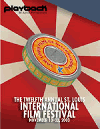 |
 ON
THE COVER• PLAYBACK GOES TO SLIFF ON
THE COVER• PLAYBACK GOES TO SLIFF
The St. Louis International Film Festival
November 13 - 23, 2003 by Rob Levy
(excerpted from Playback's Film Festival Diary)
After almost a full week of nonstop film-watching, the sickness is
starting in. This, simply, is the burnout attached with seeing gobs of
films. With that in mind, and the fact that I had a superlatively busy
evening planned out, I only saw one film.
Lustron
This is one
of two documentaries featured at an early 5 p.m. show. The theater was
back, which completely threw me off guard. Lustron is almost an
hour long, but in that hour, everything is complete and organized.
Director Bill Kubota has made a complete and enjoyable film.
In
post–World War II America, there was a massive housing problem. Harry
Truman was backed into a political corner. He had to house returning war
veterans and in an affordable manner. The answer appeared to come from
inventor Carl Strandlund, who wanted to make affordable, assembly-line
houses. His plan was to create a new housing industry, similar to the
automotive industry in scope and output. His plan was to make steel
housing out of sheets of steel. They would be constructed like fast-food
restaurants and gas stations. They could go up in 72 hours. Lustrons
were sturdy and warm, never needing painting, siding, or roofing. These
would be houses of convenience. They also would be, seemingly, the wave
of the future. It all went sixes and sevens, though, when more people
wanted a piece of Strandlund’s pie. He battled insurmountable odds,
corruption, financial heavy-handedness, and a barrage of planted
negative press. Lustron’s end boiled down to politics, greed,
and deception. Too many people wanted into the action and it all came
down. It is ironic that Lustron homes were based on plans so simple and
easy to mass market.
This
film shows the aching battles to keep Lustron going and solve the
housing crisis of the ‘50s. It also features Lustron owners, many whom
are still living in their original homes, talking passionately about the
homes they have. Clearly, this was no fad. Of the approximate 2,500
homes build, there are at least three Lustron houses in the St.
Louis metro area. I especially liked how the film talked to congressmen,
politicians, owners, and Lustron workers themselves. A complete
view of this pop culture phenomenon was given.
I
was flabbergasted at the support for this film and the following doc, Tupperware.
I think that having 5 p.m. screenings for films is a great idea. It gets
new people into the mix and offers alternative screenings for film
buffs.
________________________________________________________

Review: Lustron - The House America's Been Waiting For
by Joe Williams
November 19, 2003
• (Highly
Recommended) Full
disclosure: I not only live in a Lustron, the brand of all-metal
"house of tomorrow" that is lovingly celebrated in this
documentary, I appear in the film with my fiancée as we merrily hose
off our house and sip martinis.
That was the suburban ideal in 1949 and 1950, when visionary engineer
Carl Strandlund produced these prefab structures to meet the housing
needs of returning GIs. Strandlund's innovation was a low-maintenance
house that did not contain a stick of wood and never needed
painting. Strandlund was touted as the Henry Ford of
home-building. His Lustron delivery crews would arrive at the owner's
property and assemble a modern ranch house in a matter of days.
The swank Lustron houses were landmarks of progressive design , with
baked-on color, built-in shelves and an open floor plan. But politics
and money awakened Strandlund from his dream, as foes in the federal
government demanded repayment of the Lustron loan before the company
could turn a profit. The factory was shuttered after producing only
2,500 houses.
Then again if Strandlund had succeeded in building millions of Lustron
homes, they wouldn't be collectors' items today, and mine (#2371)
wouldn't have become a movie site.
________________________________________________________

Review: Lustron - The House America's Been Waiting For
by
Laura Kelley
November 8, 2003
*** (3 stars) This
made-for-public-television documentary focuses on Carl Strandlund, a man
with the potential to have been an industrial magnate but who failed
stupendously because of government intervention.
During the post-World War II housing crisis, Strandlund had the idea to
build
all steel homes, which he called Lustron houses, "the houses of
tomorrow." His homes were sleek, modern, inexpensive and sought
after by returning GIs and their families. And his idea fit snugly in an
era where big, space-age ideas were what sold, not what was
"cool."
The well-researched documentary by Ed Moore, Bill Kubota and Bill
Ferehawk delves into the era, the man, and the government interference
that did him in
His company actually built about 2,500 homes before going under, and
most are still standing. We meet a number of current Lustron homeowners,
who offer testimony about their love affairs with their houses.
The filmmakers even found a singer-songwriter who grew up in a Lustron
home and wrote a salute (which isn't half bad) to Strandlund.
|


